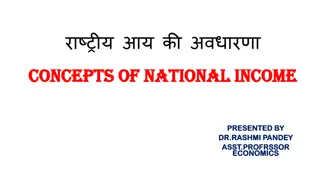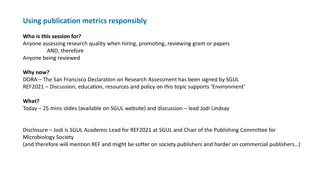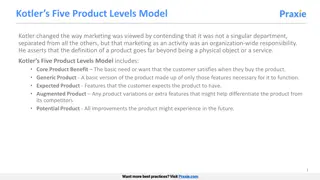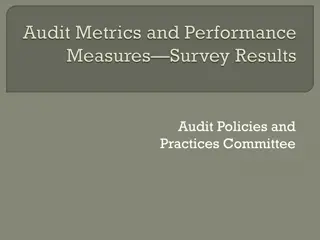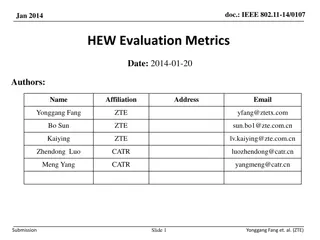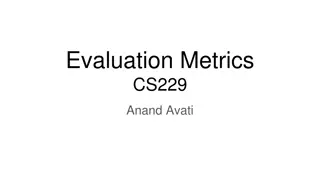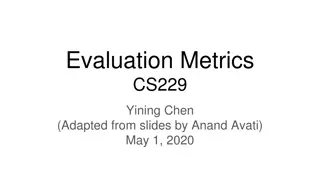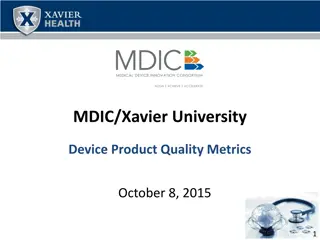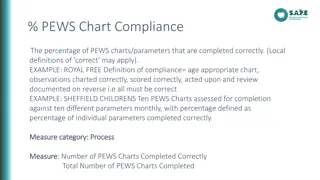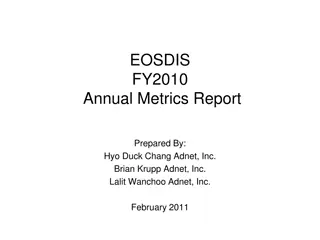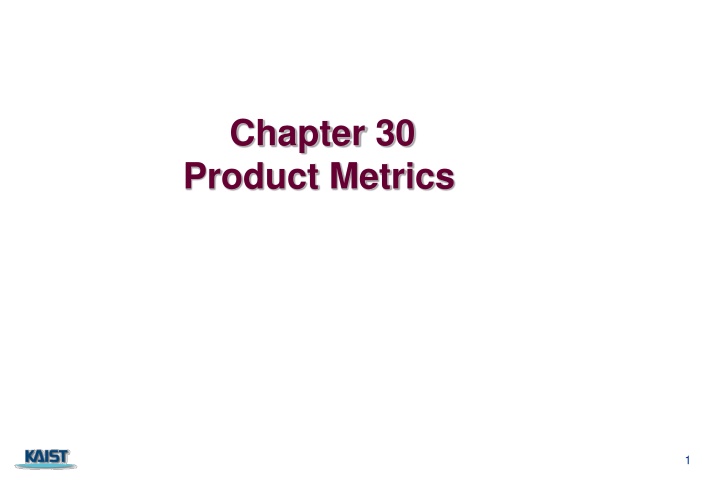
Product Metrics and Quality Factors
This content delves into product metrics, quality factors, measurement principles, and the process of formulating and interpreting software measures and metrics. It emphasizes the importance of establishing measurement objectives, deriving relevant metrics, collecting data, analyzing results, and providing feedback for software improvement.
Uploaded on | 1 Views
Download Presentation

Please find below an Image/Link to download the presentation.
The content on the website is provided AS IS for your information and personal use only. It may not be sold, licensed, or shared on other websites without obtaining consent from the author. If you encounter any issues during the download, it is possible that the publisher has removed the file from their server.
You are allowed to download the files provided on this website for personal or commercial use, subject to the condition that they are used lawfully. All files are the property of their respective owners.
The content on the website is provided AS IS for your information and personal use only. It may not be sold, licensed, or shared on other websites without obtaining consent from the author.
E N D
Presentation Transcript
Chapter 30 Product Metrics 1
McCalls Triangle of Quality (1970s) Maintainability Maintainability Flexibility Flexibility Testability Testability Portability Portability Reusability Reusability Interoperability Interoperability PRODUCT REVISION PRODUCT REVISION PRODUCT TRANSITION PRODUCT TRANSITION PRODUCT OPERATION PRODUCT OPERATION Correctness Correctness Usability Usability Efficiency Efficiency Integrity Integrity Reliability Reliability ISO 9126 Quality Factors - Functionality, reliability, usability, efficiency, maintainability, portability 2
Measures, Metrics and Indicators A SW engineer collects measures and develops metrics so that indicators will be obtained A measure provides a quantitative indication of the extent, amount, dimension, capacity, or size of some attribute of a product or process The IEEE defines a metricas a quantitative measure of the degree to which a system, component, or process possesses a given attribute. IEEE Standard Glossary of Software Engineering Terminology (IEEE Std 610.12-1990) An indicator is a metric or combination of metrics that provide insight into the software process, a software project, or the product itself Ex. Moonzoo Kim Measure: height=170cm, weight=65 kg Metric: fat metric= 0.38 ( =weight/height) Indicator: normal health condition (since fat metric < 0.5 ) 3
Measurement Principles The objectives of measurement should be established before data collection begins Ex. It is useless for black-box testers to measure a # of words in a C file. Ex. It is useful for C compiler developers to measure a # of words in a C file. Each technical metric should be defined in an unambiguous manner Ex. For measuring a total line number of a C program Including comments? Including empty lines? Metrics should be derived based on a theory that is valid for the domain of application Metrics for design should draw upon basic design concepts and principles and attempt to provide an indication of the presence of a desirable attribute Metrics should be tailored to best accommodate specific products and processes 4
Measurement Process Formulation. The derivation of software measures and metrics appropriate for the representation of the software that is being considered. Collection The mechanism used to accumulate data required to derive the formulated metrics. Analysis. The computation of metrics and the application of mathematical tools. Interpretation. The evaluation of metrics results in an effort to gain insight into the quality of the representation. Feedback. Recommendations derived from the interpretation of productmetrics transmitted to the software team. Example of Formulation To check whether a give software is hot- spotted (i.e. has intensive loops) Example of Collection Instrument a source program/binary to count how many time a given statement is executed in one second Example of Analysis. Using Excel/MatLab to get average numbers of executions of statements Example of Interpretation. If there exist statements which were executed more than 108 , on a 3 Ghz machine, then the program is hot-spotted Example of Feedback. Try to optimize those hot-spotted statements. Or those hot-spotted statement might have logical flaws 5
Goal-Oriented Software Measurement The Goal/Question/Metric Paradigm establish an explicit measurement goal define a set of questions that must be answered to achieve the goal identify well-formulated metrics that help to answer these questions. Goal definition template Analyze {the name of activity or attribute to be measured} for the purpose of {the overall objective of the analysis} with respect to {the aspect of the activity or attribute that is considered} from the viewpoint of {the people who have an interest in the measurement} in the context of {the environment in which the measurement takes place}. 6
Ex> Goal definition for SafeHome Analyze the Safehome SW architecture for the purpose of evaluating architectural components with respect to the ability to make Safehome more extensible from the viewpoint of the SW engineers performing the work in the context of produce enhancement over the next 3 years Questions Q1: Are architectural components characterized in a manner that compartmentalizes function and related data? Answer: 0 10 Q2: Is the complexity of each component within bounds that will facilitate modification and extension? Answer: 0 1 7
Metrics Attributes Simple and computable. It should be relatively easy to learn how to derive the metric, and its computation should not demand inordinate effort or time Empirically and intuitively persuasive. The metric should satisfy the engineer s intuitive notions about the product attribute under consideration Consistent and objective. The metric should always yield results that are unambiguous. Consistent in its use of units and dimensions. The mathematical computation of the metric should use measures that do not lead to bizarre combinations of unit. ex. MZ measure of a software complexity: kg x m4 An effective mechanism for quality feedback. That is, the metric should provide a software engineer with information that can lead to a higher quality end product 8
Collection and Analysis Principles Whenever possible, data collection and analysis should be automated Valid statistical techniques should be applied to establish relationship between internal product attributes and external quality characteristics Interpretative guidelines and recommendations should be established for each metric Ex. Fat metric greater than 0.5 indicates obesity. A person who has more than 0.7 fat metric should consult a doctor. 9
Overview of Ch30. Product Metrics 30.1 A Framework for Product Metrics 30.2 Metrics for the Requirement Model Function point metrics 30.3 Metrics for the Design Model Architectural design metrics Metrics for OO design Class-oriented metrics Component-level design metrics Operation oriented metrics 30.4 Design Metrics for Web and Mobile Apps 30.5 Metrics for Source Code 30.6 Metrics for Testing 30.7 Metrics for Maintenance 10
Metrics for the Analysis Model These metrics examine the analysis model with the intent of predicting the size of the resultant system Size can be one indicator of design complexity Size can always an indicator of increased coding, integration, and testing efforts Example Function-based metrics Metrics for specification quality 11
Function-Based Metrics The function point metric (FP), first proposed by Albrecht [ALB79], can be used effectively as a means for measuring the functionality delivered by a system. Function points are derived using an empirical relationship based on countable (direct) measures of software's information domain and assessments of software complexity Information domain values are defined in the following manner: number of external inputs (EIs) often used to update internal logical files number of external outputs (EOs) number of external inquiries (EQs) number of internal logical files (ILFs) Number of external interface files (EIFs) ( 12
Function Points Weighting factor Information Domain Value Count simple average complex = External Inputs ( EIs) 3 3 4 6 = External Outputs ( EOs) 3 4 5 7 = 3 External Inquiries ( EQs) 3 4 6 = 3 Internal Logical Files ( ILFs) 7 10 15 = 3 5 7 10 External Interface Files ( EIFs) Count total FP = count total x (0.65 + 0.01 x (Fi)) where Fi s are value adjustment factors based on responses to the 14 questions 13
Value Adjustment Factors (Fi) Following questions should be answered using a scale that ranges from 0 (not important) to 5 (absolutely essential) Does the system require reliable backup and recovery? Are specialized data communications required to transfer information to or from the application? Are there distributed processing functions? Is performance critical? Will the system run in an existing, heavily utilized operational environment? Does the system require on-line data entry? Does the on-line data entry require the input transaction to be built over multiple screens or operations? 15
Usage of Function Points Assume that past data indicates that one FP translates into 60 lines of code 12 FPs are produced for each person-month of effort Past projects have found an average of 3 errors per FP during analysis and design reviews 4 errors per FP during unit and integration testing These data can help SW engineers assess the completeness of their review and testing activities. Suppose that Safehome has 56 FPs 56 =50 x [0.65 +0.01 x (Fi) (= 46)] Safehome will be Expected size: 60 lines * 56 =3360 lines Expected required man-month: 1/12 MM * 56 = 4.7 MM Total analysis/design errors expected: 3 * 56 = 168 errors Total testing errors expected: 4 * 56 = 224 errors 16
Metrics for the Design Model The design of engineering products (i.e. a new aircraft, a new computer chip, or a new building) is conducted with well-defined design metrics for various design qualities Ex 1. Quality does matter, see AMD s success in 2000~2006. Ex 2. Pentium X should have Heat dispense ratio < 100 Kcal/s Should operate 99.99% time correctly at 10 Ghz Should consume less than 100 watts/h electric power The design of complex software, however, often proceeds with virtually no metric measurement Although design metric is not perfect, design without metric is not acceptable. 17
Architectural Design Metrics Architectural design metrics put emphasis on the effectiveness of modules or components within the architecture These metrics are black box Architectural design metrics Structural complexity of a module m= (# of fan-out of module m)2 Fan-out is the number of modules immediately subordinate to the module i.e. the # of modules that are directly invoked by the module Data complexity = (# of input & output variables)/ (fan-out+1) System complexity = structural complexity + data complexity 18
Morphology Metrics Morphology metrics: a function of the number of modules and the number of interfaces between modules Size = n + a Depth = the longest path from the root node to a leaf node Width =maximum # of nodes at any one level of the architecture Arc-to-node ratio 19
Metrics for OO Design-I Whitmire [WHI97] describes nine distinct and measurable characteristics of an OO design: Size Size is defined in terms of the following four views: Population: a static count of OO entities such as classes Volume: a dynamic count of OO entities such as objects Length: a measure of a chain of interconnected design elements Functionality: value delivered to the customer Complexity How classes of an OO design are interrelated to one another Coupling The physical connections between elements of the OO design The # of collaborations between classes Sufficiency the degree to which an abstraction possesses the features required of it, ... from the point of view of the current application. Whether the abstraction (class) possesses the features required of it 20
Metrics for OO Design-II Completeness An indirect implication about the degree to which the abstraction or design component can be reused Cohesion The degree to which all operations working together to achieve a single, well-defined purpose Primitiveness Applied to both operations and classes, the degree to which an operation is atomic Similarity The degree to which two or more classes are similar in terms of their structure, function, behavior, or purpose Volatility Measures the likelihood that a change will occur 21
Distinguishing Characteristics Berard [BER95] argues that the following characteristics require that special OO metrics be developed: Encapsulation the packaging of data and processing Information hiding the way in which information about operational details is hidden by a secure interface Inheritance the manner in which the responsibilities of one class are propagated to another Abstraction the mechanism that allows a design to focus on essential details Localization the way in which information is concentrated in a program 22
Class-Oriented Metrics Proposed by Chidamber and Kemerer (CK metrics): Weighted methods per class (Ci) where Ci is a normalized complexity for method i The # of methods and their complexity are reasonable indicators of the amount of effort required to implement and test a class As the # of methods grows for a given class, it is likely to become more application specific -> less reusability Counting the # of methods is not trivial Depth of the inheritance tree As DIT grow, potential difficulties when attempting to predict the behavior of a class 23
Class-Oriented Metrics Number of children/subclasses (NOC) As NOC grows, more reuse, but the abstraction of the parent class is diluted As NOC grows, the amount of testing will also increase Coupling between object classes (CBO) CBO is the # of collaborations listed on CRC index cards As CBO increases, reusability decreases Response for a class (RFC) A set of methods that can be executed in response to a request As RFC increases, test sequence grows Lack of cohesion in methods (LCOM) A # of methods that access same attributes 24
Applying CK Metrics Shakira: Wasn't too complicated. I went back to my UML class and sequence diagrams, like you suggested, and got rough counts for DIT, RFC, and LCOM. I couldn't find the CRC model, so I didn't count CBO. Jamie (smiling): You couldn't find the CRC model because I had it. Shakira: That's what I love about this team, superb communication. Vinod: I did my counts . . . did you guys develop numbers for the CK metrics? The scene: Vinod's cubicle. The players: Vinod, Jamie, Shakira, Ed members of the SafeHome software engineering team, who are continuing work on component-level design and test case design. The conversation: Vinod: Did you guys get a chance to read the description of the CK metrics suite I sent you on Wednesday and make those measurements? 25 25
should look for classes that have bad numbers in at least two or more of the CK metrics. Kind of two strikes and you're modified. Shakira (looking over Ed's list of classes with high RFC): Look, see this class? It's got a high LCOM as well as a high RFC. Two strikes? Vinod: Yeah I think so . . . it'll be difficult to implement because of complexity and difficult to test for the same reason. Probably worth designing two separate classes to achieve the same behavior. Jamie: You think modifying it'll save us time? Vinod: Over the long haul, yes. (Jamie and Ed nod in the affirmative.) Jamie: Since I had the CRC cards, I took a look at CBO, and it looked pretty uniform across most of the classes. There was one exception, which I noted. Ed: There are a few classes where RFC is pretty high, compared with the averages . . . maybe we should take a look at simplifying them. Jamie: Maybe yes, maybe no. I'm still concerned about time, and I don't want to fix stuff that isn't really broken. Vinod: I agree with that. Maybe we 26 26
Class-Oriented Metrics The MOOD Metrics Suite Method inheritance factor (MIF) MIF = Mi(Ci)/ Ma(Ci) Mi(Ci) = the # of methods inherited (and not overridden) in Ci Md(Ci) = the # of methods declared in the class Ci Ma(Ci) = Md(Ci) + Mi(Ci) Coupling factor CF = is_client(Ci,Cj)/ (Tc2-Tc) Is_client = 1 if and only if a relationship exists between the client class Cc and Cs (Cc != Cs) High CF makes trouble to understandability, maintainability and reusability. 27
Class-Oriented Metrics Proposed by Lorenz and Kidd [LOR94]: class size number of operations overridden by a subclass number of operations added by a subclass 28
Component-Level Design Metrics Cohesion metrics a function of data objects and the locus of their definition Coupling metrics a function of input and output parameters, global variables, and modules called Complexity metrics hundreds have been proposed (e.g., cyclomatic complexity) 29
Operation-Oriented Metrics Proposed by Lorenz and Kidd [LOR94]: average operation size # of messages sent by the operation operation complexity average number of parameters per operation 30
Metrics for Source Code Halstead s Software Science: a comprehensive collection of metrics based on the number (count and occurrence) of operators and operands within a component or program n1: # of distinct operators that appears in a program n2: # of distinct operands that appears in a program N1: # of operator occurrences N2: # of operand occurrences Program length N = n1 log2 n1 + n2 log2 n2 Program volume V= (N1+N2) log2 (n1 + n2) And many more metrics 31
Cyclometic Complexity A quantitative measure of the logical complexity Cyclomatic complexity defines the # of independent paths to test for complete statement/branch coverage - number of simple decisions + 1 - number of edge number of node +2 - number of enclosed areas + 1 - In this case, V(G) = 4 32 CS350
Metrics for Testing Testing effort can also be estimated using metrics derived from Halstead measures Binder [BIN94] suggests a broad array of design metrics that have a direct influence on the testability of an OO system. Lack of cohesion in methods (LCOM). Percent public and protected (PAP). Public access to data members (PAD). Number of root classes (NOR). Fan-in (FIN). Number of children (NOC) and depth of the inheritance tree (DIT). 33
Metrics for Maintenance IEEE Std 982.1-1998 Software Maturity Index (SMI) SMI = [Mt - (Fa + Fc + Fd)]/Mt Mt = # of modules in the current release Fc = # of modules in the current release that have been changed Fa = # of modules in the current release that have been added Fd = # of modules from the preceding release that were deleted in the current release 34
Design Structure Quality Index (DSQI) Developed by U.S. Air Force Systems Command DSQI (ranging 0 to 1) is calculated from the following 7 values S1 = the total # of modules define in the program architecture S2 = the # of modules whose correct function depends on the source of data input or that produce data to be used elsewhere S7 = the # of modules with a single entry and exit 36


